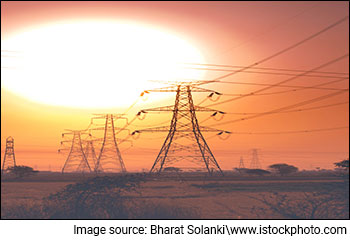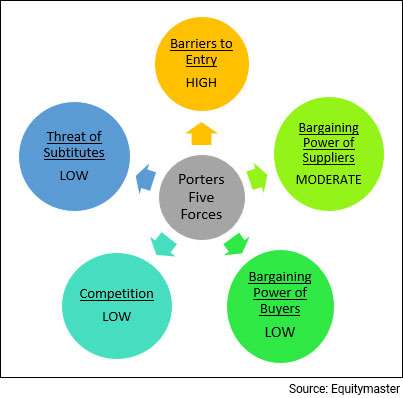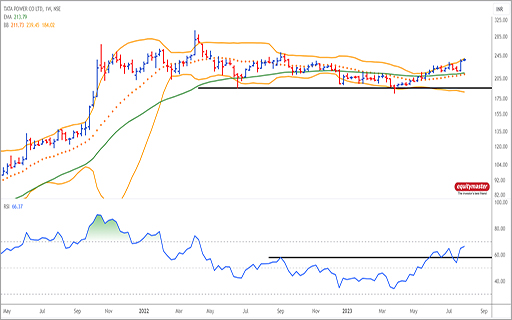Investment in securities market are subject to market risks. Read all the related documents carefully before investing
2 Stocks to BUY
As Nifty50 Heads Towards 40,000
- Home
- Outlook Arena
- Best Power Stocks in India
Best Power Stocks in India

Power is one of the most critical components of infrastructure, crucial for the economic growth and welfare of nations.
India is the world's third-largest producer as well as the third-largest consumer of power (electricity).
The country's power sector has made significant inroads over the last decade, doubling its installed capacity from 200 gigawatts (GW) in the financial year 2012 to 403 GW in the financial year 2022.
This comes on the back of strong reforms from the Ministry of Power. They have turned the country from one with a power shortage to one with a surplus by establishing a single national grid, fortifying the distribution network, and achieving universal household electrification.
Despite the significant increase in the power generation capacity, India still faces challenges in meeting the growing demand for power as reliable supply remains low in the country.
Electricity demand is on the rise. This is attributable to the growing population, rising levels of electrification in villages and smaller towns and a robust per-capita usage. The per capita consumption is less than a third of the global average highlighting the opportunity for growth. The demand for power in India is expected to grow threefold between 2018 and 2040.
India's power sector is one of the most diversified in the world. Sources of power generation range from conventional sources such as coal, lignite, natural gas, oil, hydro and nuclear power, to viable non-conventional sources such as wind, solar, agricultural and domestic waste.
However, we are still largely dependent on conventional sources such as coal. Coal-fired (including lignite) thermal power plants account for more than 50% of the total installed capacity.
Porter's Five Forces Analysis of the Power Sector in India
Porter's Five Forces is a model that identifies and analyzes five competitive forces that shape every industry.
These are barriers to entry, bargaining power of suppliers, bargaining power of customers, threat of substitutes and competition within the industry.
A change in any of the forces normally requires a company to re-assess the marketplace.
Let us have a look at how these five forces shape the power sector:
#1 Barriers to Entry
The most attractive segment is one in which barriers to entry are high as they restrict the threat of new entrants.
Conversely if the barriers are low, the risk of new companies venturing into a given market is high.
In the power sector, barriers to entry are high. Moreso in in the transmission and distribution segments, which are largely state monopolies. The primary reasons are high fixed costs, fuel linkages and payment guarantees from state governments that buy power and retail distribution license.
#2 Bargaining Power of Suppliers
The bargaining power of suppliers is the ability of suppliers to put the firm under pressure. Suppliers may refuse to work with the firm or charge excessively high prices for unique resources.
The bargaining power of suppliers in the power sector is moderate since the tariff structure is mainly regulated.
#3 Bargaining Power of Customers
The bargaining power of customers is the ability of customers to put the firm under pressure. It is high if buyers have many alternatives and low if they have few choices.
In the power sector, the bargaining power of customers is low. Despite low switching costs and the fact that electricity is an undifferentiated product, customers don't tend to change their source of electricity often.
#4 Competition
For most industries, understanding the competition is vital to successfully marketing or selling a product.
The competition in the power industry is low, as new entrants are dissuaded by a shortage of inputs such as natural gas and regulatory hurdles.
#5 Threat of Substitutes
A substitute product uses a different technology to try to solve the same economic need.
The threat of substitutes for the power sector is low as there is no alternative to power. Whereas within the sector, the threat of substitutes is moderate as the cost of switching to substitutes like solar, wind energy etc. is still high.
However, as the industry is still transforming and once the substitute sources become viable, the threat of substitutes can rise over the long term.
Porters Five Forces Analysis of the Power Sector in India

When to Invest in Power Stocks
The demand for power is closely linked to the economic growth which makes it a highly cyclical industry. This means that for some reason the economy and by extension the stock market flounders, so will power stocks.
Since economic cycles affect the earnings prospects, the best time to buy power stocks is at the start of an economic expansion. And the best time to sell is just before the economy begins to slow down.
So, if you invest in an power stock at the peak of an economic cycle there is good chance you will lose a huge chunk of the investment. Nevertheless, identifying the bottom of the cycle is not an easy task.
In the past decade, the power sector has provided investors healthy returns but overall, the performance of the sector has been underwhelming. However, with the advent of the renewable power in the country, this is likely to change.
Companies producing power with conventional sources have pivoted their businesses to focus on developing cleaner sources of energy. So, a good time to look at power stocks would be now, when companies are ramping up their clean energy sources.
The demand for power should continue to increase. With a rising urban population, the need for clean and infallible power supply gives immense scope for growth in the power sector.
Key Points to Keep in Mind While Investing in Power Stocks
Here are some key points to take note of before you invest in power stocks:
#1 Cyclicality of the sector
This is the most important factor one must keep in mind while investing in power stocks.
The power sector, being cyclical, is dependent on business cycles and economic conditions. As the demand for power is closely linked to the economy, power stocks are usually riskier - their fortunes are prone to economic booms and busts.
Usually, cyclical stocks can be used to generate high returns when the economy is doing well and vice versa.
#2 The shift towards cleaner sources of power (energy)
From EPC projects to energy generation and transmission, power companies are deep diving into every facet of the renewable segment. This renewed focus makes renewable power a noteworthy sector for the long-term.
As the world looks for alternative fuel sources, this sector has garnered a lot of attention of late.
Companies with coal-based power plants are also pivoting their businesses to focus on renewable energy sources. This monumental transition towards cleaner sources presents a huge money-making opportunity for investors.
#3 Competitive landscape
The monumental transition towards cleaner sources and strong growth prospects of the country has attracted several companies to invest in the renewables sector.
They are pivoting their business and operating in the market either through joint ventures with local partners or via independently owned operations.
This is bound to change the competitive landscape and is already churning of market shares amongst the top players.
While this is likely to continue for some time, the incumbent players should end up with a lion's share over the next decade.
#4 Profitability of the company
The sector has a low bargaining power and a fixed tariff structure set by the regulators. Therefore the sector operates on thin margins.
Here's a list of top power companies in India based on their consolidated net operating profit.
| Company | Net Sales (Rs m) | Operating Profit (Rs m) | Consolidated Net Profit (Rs m) |
|---|---|---|---|
| NTPC Ltd. | 11,48,575 | 3,91,867 | 1,61,114 |
| Power Grid Corporation Of India Ltd. | 3,99,281 | 3,73,295 | 1,70,938 |
| NHPC Ltd. | 83,538 | 44,683 | 35,377 |
| Torrent Power Ltd. | 1,37,157 | 36,297 | 4,097 |
| Sembcorp Energy India Ltd. | 76,891 | 22,130 | 1,424 |
| SJVN Ltd. | 24,220 | 19,527 | 9,775 |
| CESC Ltd. | 72,939 | 14,092 | 8,158 |
| Jaiprakash Power Ventures Ltd. | 46,246 | 13,479 | 1,085 |
| JSW Energy Ltd. | 36,427 | 12,728 | 5,698 |
Data as of March 2022
#5 Debt to equity (D/E) ratio
A company uses both equity and debt to run a business. However, the amount of debt it uses indicates its fixed obligations. Higher the leverage, higher will be the fixed charges such as interest expense which will lower the profitability.
Therefore, one must look for a debt-to-equity ratio of one or less than one.
Here's a list of top power companies in India with low debt to equity ratio.
| Company | Debt to Equity (x) |
|---|---|
| Inox Wind Energy Ltd. | 0.04 |
| JSW Energy Ltd. | 0.09 |
| PTC India Ltd. | 0.26 |
| Reliance Infrastructure Ltd. | 0.38 |
| SJVN Ltd. | 0.42 |
| Jaiprakash Power Ventures Ltd. | 0.47 |
| Reliance Power Ltd. | 0.69 |
| Adani Power Ltd. | 0.72 |
| Sembcorp Energy India Ltd. | 0.77 |
Data as of March 2022
#6 Return on Capital Employed (ROCE) ratio
Along with a low debt to equity ratio, a one must look for a high return on capital employed (ROCE).
Return on capital employed measures how much profits the company is generating through its capital. The higher the ratio, the better.
A ROCE of above 15% is considered decent for companies that are in an expansionary phase.
Power companies operate on a fixed tariff regime, which hampers their return ratios. Hence most of them operate on a ROCE of 14% or lower.
Here's a list of top power companies in India with ROCE of more than 10%.
| Company | ROCE (%) |
|---|---|
| Power Grid Corporation Of India Ltd. | 14.2 |
| PTC India Ltd. | 13.3 |
| Inox Wind Energy Ltd. | 10.3 |
Data as of March 2022
#7 Valuations
Two commonly used financial ratios used in the valuation of power stocks are -
Price to Earnings Ratio (P/E) - It compares the company's stock price with its earnings per share. The higher the P/E ratio, the more expensive the stock.
To find stocks with favorable P/E Ratios, check our list of stocks according to their P/E Ratios.
Price to Book Value Ratio (P/BV) - It compares a firm's market capitalization to its book value. A high P/BV indicates markets believe the company's assets to be undervalued and vice versa.
To find stocks with favorable P/BV Ratios, check our list of stocks according to their P/BV Ratios.
#8 Dividend yields
The power sector has a consistent trend of dividend yields. However, it varies depending on the owner's discretion.
Here's a list of top power companies in India that score well on dividend yield and dividend payout.
| Company | Dividend Yield (eoy) | Dividend Payout (%) |
|---|---|---|
| PTC India Ltd. | 9.6 | 75 |
| Power Grid Corporation Of India Ltd. | 6.8 | 147.5 |
| NHPC Ltd. | 6.5 | 18.1 |
| SJVN Ltd. | 6.2 | 17 |
| CESC Ltd. | 5.9 | 450 |
| NTPC Ltd. | 5.2 | 70 |
Data as of March 2022
For more details, check out the top stocks offering high dividend yields.
Top Power Stocks in India
The power sector is transforming. The top power stocks in India can immensely benefit with a variety of factors positively affecting the industry.
Here are the top power stocks in India which score well on crucial parameters.
| Company | RoE (Latest, %) | D/E (Curr FY, x) | Sales CAGR (3 yrs, %) | Profit CAGR (3 yrs, %) |
|---|---|---|---|---|
| NTPC Ltd. | 13.24 | 1.35 | 5.30% | 6.40% |
| Power Grid Corporation Of India Ltd. | 29.33 | 2.18 | 4.40% | 19.90% |
| PTC India Ltd. | 11.37 | 0.26 | -4.80% | 35.50% |
| Torrent Power Ltd. | 4.05 | 0.79 | 1.40% | -23.20% |
| Adani Green Energy Ltd. | -3.58 | 7.62 | 73.10% | NA |
| NHPC Ltd. | 14.09 | 1 | -2.40% | 7.70% |
| Sembcorp Energy India Ltd. | 1.29 | 0.77 | NA | NA |
| CESC Ltd. | 8.19 | 0.84 | -11.90% | -10.30% |
| Jaiprakash Power Ventures Ltd. | 1.58 | 0.47 | 5.90% | NA |
| JSW Energy Ltd. | 4.55 | 0.09 | -26.40% | -4.40% |
List of Power Stocks in India
The details of listed power companies can be found on the NSE and BSE website. However, the overload of financial information on these websites can be overwhelming.
For a more direct and concise view of this information, you can check out our list of power stocks.
Best Sources for Information on the Power Sector
Indian Brand Equity Foundation Powers and Mining Sector Report - https://www.ibef.org/industry/power
Ministry of Power - https://powermin.gov.in/
Ministry of New & Renewable Energy - https://mnre.gov.in/
So, there you go. Equitymaster's detailed guide on the top power stocks in India is simple and easy to understand. At the same time, it offers detailed analysis of both the sector and the top stocks in the sector.
You can also checkout our playlist on Power Stocks on Equitymaster's YouTube channel.
Here's a list of articles and videos on the power sector and top power stocks in India. This is a great starting point for anyone who is looking to explore more about power stocks and the power sector.
Disclaimer: This article is for information purposes only. It is not a stock recommendation and should not be treated as such. Learn more about our recommendation services here...
![]() Why SJVN Share Price is Rising
Why SJVN Share Price is Rising
Aug 11, 2023
Here's why shares of this mid-cap company touched their 52-week high yesterday.
![]() Tata Power Share Price is Rising. Is Now the Time to Buy?
Tata Power Share Price is Rising. Is Now the Time to Buy?
Jul 31, 2023
A close look at Tata Power from a technical perspective. Here's what the charts suggest...
![]() Why Adani Transmission Share Price is Falling
Why Adani Transmission Share Price is Falling
May 9, 2023
Adani Transmission share price sinks 5%, hitting lower circuit. Here's why.
![]() Why Tata Power Share Price is Falling
Why Tata Power Share Price is Falling
Mar 27, 2023
The stock recently hit a new 52-week low. Find out why.
![]() This Summer Season, Don't Buy Power Stocks. Instead Look at These 5 Companies...
This Summer Season, Don't Buy Power Stocks. Instead Look at These 5 Companies...
Mar 15, 2023
Take a look at these five companies that are poised to benefit from the scorching temperatures and surging demand.
![]() Top 5 Power Companies in India by Growth
Top 5 Power Companies in India by Growth
Jan 30, 2023
With power consumption on the rise, these five power companies are worth keeping an eye on.
![]() Breakout Sector for 2023
Breakout Sector for 2023
Nov 16, 2022
An underrated sector set to revive with financial reforms and create multibaggers.
![]() Should the Stock of Adani Power Trade at 2x NTPC?
Should the Stock of Adani Power Trade at 2x NTPC?
Aug 26, 2022
Adani Power gained 300% in 2022. Why shouldn't other power stocks like NTPC enjoy the same kind of valuations?
![]() Power Stocks Rise with Temperature. Is the Momentum Here to Stay?
Power Stocks Rise with Temperature. Is the Momentum Here to Stay?
Apr 13, 2022
Power stocks surge with an expectation of high demand during summer.
Why I'm Bullish on Power Stocks
Sep 23, 2021
This is why I think buying power stocks is a good idea.
![]() Power Stocks: Value Buys or Value Traps?
Power Stocks: Value Buys or Value Traps?
Aug 4, 2023
Power stocks have found favour after a long wait. Find out what lies ahead for them and how to invest in the best power companies.
![]() Investing in Power Stocks?
Investing in Power Stocks?
Jul 26, 2023
What's the outlook for power stocks? Find out...
![]() Why Bajaj Finance Share Price is Falling
Why Bajaj Finance Share Price is Falling
Mar 28, 2023
Bajaj Finance experiences another setback, declines 8% in a month. Here's why.
![]() Nifty Energy Index: Bulls Capitalizing on Technical Support
Nifty Energy Index: Bulls Capitalizing on Technical Support
Mar 27, 2023
Charts suggest a possible recovery in the Nifty Energy index. The index was down around 16% in the first two months of 2023 but saw a recovery March 2023.
![]() Why Adani Power Share Price is Falling
Why Adani Power Share Price is Falling
Feb 10, 2023
With no respite for investors, Adani Power shares are down more than 40% in 2023 so far. How will the company improve its fortunes?
![]() Why Adani Transmission Share Price is Falling
Why Adani Transmission Share Price is Falling
Jan 25, 2023
Power stocks have underperformed recently and are losing steam. Adani Transmission shares are down 30% in just two months.
![]() Best Sector for 2022
Best Sector for 2022
Sep 2, 2022
In this video, I'll share my view on the best sector for trading this year.
![]() Power Stocks: An Era of Outperformance
Power Stocks: An Era of Outperformance
Aug 22, 2022
Should you cash in on this opportunity?
![]() Focus: Power Sector Stocks
Focus: Power Sector Stocks
Jan 11, 2022
Power stocks are ready to break out. Get ready to buy them...
EVs Will Change the Fortunes of this 3% Return Sector
Sep 22, 2021
Companies across industries are pouring in billions into this sector.
FAQs
Which are the Top Power Companies In India right now?
As per Equitymaster's Indian stock screener, here is the list of the top power stocks in India right now...
- #1 NTPC
- #2 POWER GRID
- #3 ADANI GREEN ENERGY
- #4 ADANI POWER
- #5 ADANI TRANSMISSION
These companies are investing in the renewable power segment and keeping themselves ahead of the competition.
Note that, there are various other parameters you should take into account before investing in any company such as promoter holding etc. Sustained research must not be compromised despite the positive odds.
Which are the power stocks with the best shareholder returns?
Power Grid and NTPC were the top performers over the last 5 years in terms of sales and profit growth.
Power Grid's growth was led by its leadership status in the company and support from the Government considering it is a PSU.
NTPC, also a PSU, is India's largest power-generation utility has the done well in the domestic power sector on account of its leadership status and well-established relations with the state distribution companies.
To know which other companies performed well over the last 5 years, check out our entire list of top performers.
What kind of dividend yields do power stocks offer?
The power sector has a consistent trend of dividend yields. However, it varies depending on the owner's discretion.
At present, Power Grid, JSW Energy, Tata Power and NTPC offer attractive dividend yields to their shareholders.
For more, check out the top dividend yield stocks on Equitymaster's Indian stock screener.
Which are the top gainers and top losers within the power sector today?
Within the Power sector, the top gainers were NLC INDIA (up 2.2%) and ADANI POWER (up 2.2%). On the other hand, TORRENT POWER (down 4.6%) and BF UTILITIES (down 3.9%) were among the top losers.
For more, please visit the BSE power index live chart and also check out our power sector report.



















